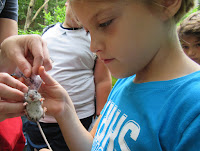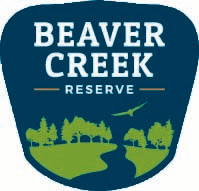Although nature’s annual display of brilliant foliage has come and gone, the days are growing continually shorter, and we are finding ourselves immersed in the holiday season, the beginning of winter here at Beaver Creek Reserve is also marked by the finalization of all of our summer projects. At the Citizen Science Center, we had a fantastic 2016 summer season, with a number of fun and educational citizen science programs, and a great volunteer turnout. One of the CSC’s most notable projects this year was our Biotic Inventory.
 |
Scientists hard at work on the
Biotic Inventory |
The Biotic Inventory was a key project for the CSC this year, as it was used to accomplish several of BCR’s major goals. The Biotic Inventory allowed us to host nature experts who surveyed our property’s flora and fauna to add to our existing species list. This up-to-date species list will assist in the creation of a Comprehensive Forest Land Use Plan that will help us make educated decisions about how to manage our diverse property. The Inventory also successfully brought together local citizens and volunteers who have contributed their knowledge and skill in developing this species list. In addition, the Inventory provided volunteers and local citizens with the opportunity to connect with nature, one outcome that BCR is always working hard to meet.
Experts and citizen scientists, equipped with hand lenses, insect nets, bug spray, and field guides, surveyed a wide range of taxon, including lichens, frogs, toads, plants, insects, reptiles, amphibians, land snails, mammals, spiders, and many more. Though some surveys were more fruitful than others, we are very happy with the results of our survey and the updated snapshot of our species composition here at BCR. For example, what’s not to lichen about the 27 species identified during our Lichen Program? Or the 20 species of spiders we discovered without leaving the vicinity of the Nature Center?
 |
Journey examining a vole during the
Mammal program |
In addition to the help of citizen scientists, we had several professional scientists assist with the Biotic Inventory by leading programs about different organisms found on the reserve. Professor Julie Beston from the University of Wisconsin – Stout was one such volunteer. She helped set up live mammal traps to record the number of shrews, voles, red and grey squirrels, chipmunks, white-tailed deer, and martens at the reserve. For the Biotic Inventory Land Snails Program, local snail expert Matt Kuchta, also from the University of Wisconsin – Stout, taught citizen scientists how to survey the forest for snails. Many of the terrestrial snails in Wisconsin are so small that they would barely cover Abraham Lincoln's nose on a penny. Dr. Todd Wellnitz from the University of Wisconsin – Eau Claire taught a handful of our volunteers to locate and identify both aquatic and terrestrial insects in our Biotic Inventory Bug Program. With the help of insect nets, we discovered 33 species of dragonflies, and easily verified the “healthy stream triad” of mayfly, stonefly, and caddisfly nymphs in Deinhammer Creek and Beaver Creek.
 |
Collecting an array of aquatic insects
for the Bug Program |
Along with professionals from educational institutions, we were lucky enough to have herptile expert Rori Paloski from the WDNR lead two great programs about reptiles and amphibians. In the reptile program, Rori and a group of volunteers identified several species of snakes using pre-placed reptile cover boards. These cover boards also allowed the group to get up close and personal with a prairie skink and her six eggs. During her amphibian program, Rori discussed the 12 species of frogs that live in Wisconsin and played their calls for participants, before leading a walk in the marsh on the south trails to listen for the calls. By the time the program was finished, participants were able to identify five different frog species just by listening to their call. With all of this help, it is no wonder that our Biotic Inventory was so successful.
 |
We found and held three species of snakes
during the Reptile Program |
In addition to collecting excellent scientific data and creating unique citizen science opportunities, this summer’s Biotic Inventory programs were a wonderful time to spend with fellow citizen scientists. We are looking forward to unveiling what we have planned for the next year!
Written by Tera Maldonado
With additions by Alison Campbell


